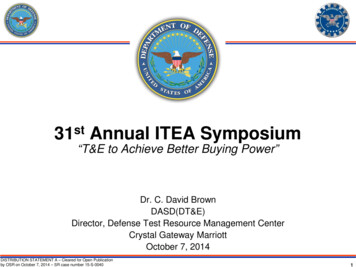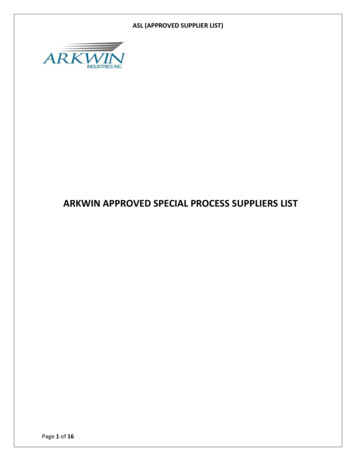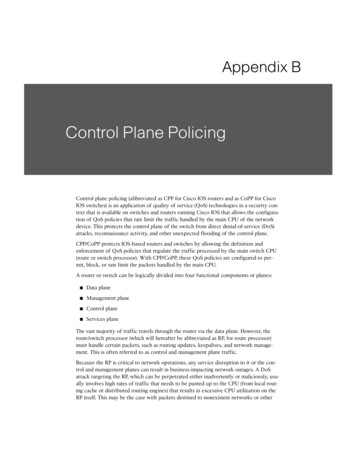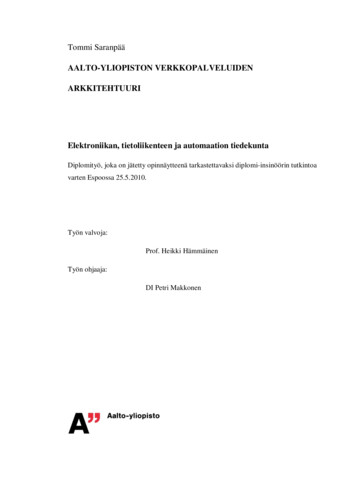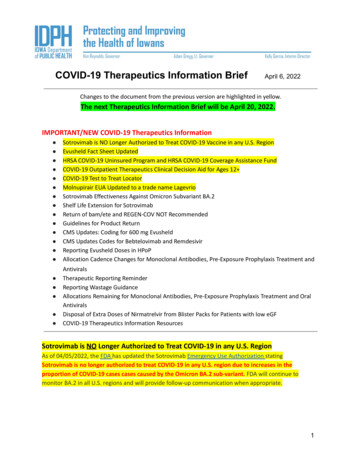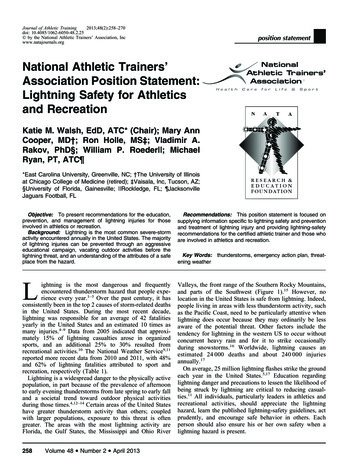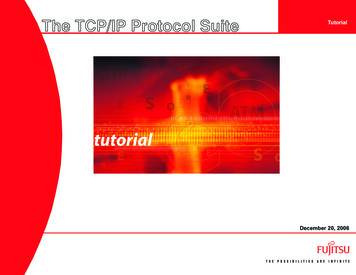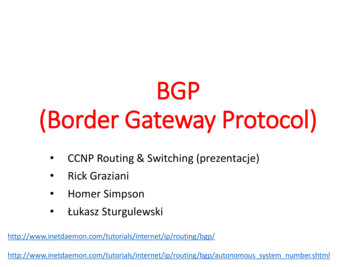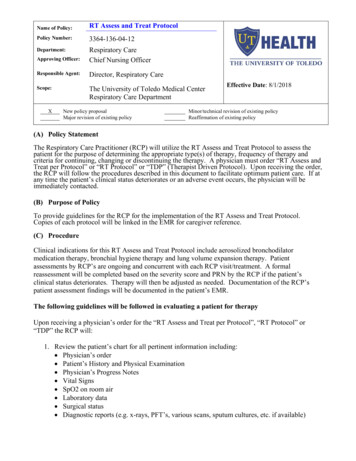
Transcription
Name of Policy:RT Assess and Treat ProtocolPolicy Number:3364-136-04-12Department:Approving Officer:Respiratory CareChief Nursing OfficerResponsible Agent:Director, Respiratory CareScope:The University of Toledo Medical CenterRespiratory Care DepartmentXNew policy proposalMajor revision of existing policyEffective Date: 8/1/2018Minor/technical revision of existing policyReaffirmation of existing policy(A) Policy StatementThe Respiratory Care Practitioner (RCP) will utilize the RT Assess and Treat Protocol to assess thepatient for the purpose of determining the appropriate type(s) of therapy, frequency of therapy andcriteria for continuing, changing or discontinuing the therapy. A physician must order “RT Assess andTreat per Protocol” or “RT Protocol” or “TDP” (Therapist Driven Protocol). Upon receiving the order,the RCP will follow the procedures described in this document to facilitate optimum patient care. If atany time the patient’s clinical status deteriorates or an adverse event occurs, the physician will beimmediately contacted.(B) Purpose of PolicyTo provide guidelines for the RCP for the implementation of the RT Assess and Treat Protocol.Copies of each protocol will be linked in the EMR for caregiver reference.(C) ProcedureClinical indications for this RT Assess and Treat Protocol include aerosolized bronchodilatormedication therapy, bronchial hygiene therapy and lung volume expansion therapy. Patientassessments by RCP’s are ongoing and concurrent with each RCP visit/treatment. A formalreassessment will be completed based on the severity score and PRN by the RCP if the patient’sclinical status deteriorates. Therapy will then be adjusted as needed. Documentation of the RCP’spatient assessment findings will be documented in the patient’s EMR.The following guidelines will be followed in evaluating a patient for therapyUpon receiving a physician’s order for the “RT Assess and Treat per Protocol”, “RT Protocol” or“TDP” the RCP will:1. Review the patient’s chart for all pertinent information including: Physician’s order Patient’s History and Physical Examination Physician’s Progress Notes Vital Signs SpO2 on room air Laboratory data Surgical status Diagnostic reports (e.g. x-rays, PFT’s, various scans, sputum cultures, etc. if available)
Policy 3364-136-04-12RT Assess and Treat ProtocolPage 22. Perform a physical assessmenta) General observations: patient’s color, pattern and effort of breathing, chest expansion(symmetrical and bilateral), level of consciousness and the ability to ambulate.b) Cough and sputum production: Ability to take a deep breath as measured using an IncentiveSpirometer. Effectiveness of cough as assessed by measuring peak flows. The RCP willask the patient to cough and expectorate into a tissue for observation of color and viscosityand determine if suctioning will be required. If the patient is unable to produce sputum, theRCP should question the patient with regard to their sputum production, color, consistency,frequency and amount.c) Percussion and palpation of the lung fields to assess and identify: Areas of tenderness Observe any chest wall abnormalities Respiratory excursion and fremitis, to determine whether the underlying tissues are airfilled, fluid-filled or solid. This is not always indicated for all patients but can be helpfuld) Auscultation of the lung fields (which will help to identify respiratory therapy objectives andcare plan) To evaluate the airflow through the tracheobronchial tree and detect any possibleobstructions Breath soundso Normalo Crackleso Rhonchio Wheezes or pleural rubsAfter the patient’s overall assessment is complete, the RCP will initiate one, two, or all three of thefollowing protocols based on assessment findings:Bronchodilator Aerosol Therapy1. Perform initial assessment for Bronchodilator Aerosol Therapy. Indications for bronchodilatoraerosol therapy include: Relieve, reduce or prevent re-occurring bronchospasm Relieve, reduce or prevent re-occurring airway inflammation and mucosal edema2. Patients will be scored based on the RCP’s findings as documented in the patient’s EMR. Thetype and frequency of the therapy will be determined based on this score as it falls into one offour (4) acuity levels. These levels are “Minimal”, “Mild”, “Moderate” and “Severe”.a) Minimal Score (0-2 points) No indications for bronchodilators. Continue home regimen if applicableb) Mild Score (3-5 points) Albuterol 2.5 mg or 2 puffs Q4hr PRN W/A x 2 tx with automatic DC at 24 hrs. if scoreremains 3
Policy 3364-136-04-12RT Assess and Treat ProtocolPage 3 Continue, review controller medications from home if applicable. Contact physician foradjustment of controller meds.RT to reassess within 72 hoursc) Moderate Score (6-8 points) Albuterol/Ipratropium MDI 2 puffs inhaled or nebulizer (0.5 mg Ipratropium/2.5 mgAlbuterol) Q6 hr. W/A Albuterol 2.5 mg nebulizer or 4 puffs inhaled Q2 hr. PRN forshortness of breath. Continue controller medications from home regimen if applicable RT to reassess within 48 hoursd) Severe Score ( 9 points) Ipratropium 0.5 mg/Albuterol 2.5 mg (DuoNeb) Q6 hr. Albuterol 2.5 mg Q2 hr. PRN Formal reassessment within 24 hoursIf no improvement/poor response ( 12 hrs.) or near extremis, contact physician forconsideration of: Pulmonary consult 5 mg Albuterol via SVN x 3 back-to-back treatments Increase dosing, progress to greater frequency Full face mask NPPV ICU admit Heliox therapyLung Expansion Therapy1. Perform initial assessment for Lung Expansion Therapy. Indications for lung expansiontherapy include: Moderate hypoxemia while on oxygen therapy (e.g. SpO2 90% on 3-5 lpm O2 or greater) Prevent or treat atelectasis2. Patients will be scored based on the RCP’s findings as documented in the patient’s EMR Thetype and frequency of the therapy will be determined based on this score as it falls into one offour (4) acuity levels. These levels are “Minimal”, “Mild”, “Moderate” and “Severe”.a) Minimal Score (0-2 points) Deep Breathing / Cough – 3-5 maneuvers Q1hr. W/A – RT to perform initial coachb) Mild Score (3-5 points) Deep Breathing / Cough – 3-5 maneuvers Q1hr. W/A – RT to perform initial coach withnurse to supervise ongoing RT to reassess within 72 hoursc) Moderate Score (6-8 points) Positive expiratory pressure (PEP) device. Target of 10-20 cmH2O - TID If no improvement/poor response after 12 hours of PEP therapy then CPAP @ 8-10 cmH2O for 2 hr. duration RT to reassess within 48 hours
Policy 3364-136-04-12RT Assess and Treat ProtocolPage 4d) Severe Score ( 9) MetaNeb (CHFO/CPEP mode) Q4hr W/A x 24 hrs. then QID If no improvement/poor response after 24 hrs. of MetaNeb therapy then Full face mask CPAP at 8-10 cmH2O x 3 hrs. Q6 hrs. x 24 hrs.Bronchial Hygiene TherapyPerform initial assessment for Bronchial Hygiene Therapy. Indications for bronchial hygiene therapyinclude: Difficulty with secretion clearance unresponsive to simpler techniques Atelectasis associated with mucous plugging History of Cystic Fibrosis, Chronic Bronchitis or BronchiectasisPatients will be scored based on the RCP’s findings as documented in the patient’s EMR. The typeand frequency of the therapy will be determined based on this score as it falls into one of four (4)acuity levels. These levels are “Minimal”, “Mild”, “Moderate” and “Severe”.1. Minimal Score (0-2 points) Deep Breathing / Cough – 3-5 maneuvers Q1hr W/A – RT to perform initial coach2. Mild Score (3-5 points) Deep Breathing / Cough – 3-5 maneuvers Q1hr W/A – RT to perform initial coach If no improvement/poor response after 12 hours Acapella 3-5 maneuvers TID – RT to perform initial coach RT to reassess within 72 hours3. Moderate Score (6-8 points) EZPap/Acapella/Percussion therapy TID. Vest therapy may be used if appropriate. For Cystic Fibrosis/Bronchiectasis: Vest therapy Q6 hr. W/A x 24 hrs. then BID For Neuromuscular cough weakness: Cough Assist Device Q6hr. W/A RT to reassess within 48 hours4. Severe Score Intrapulmonary Percussive therapy (MetaNeb – CHFO & CPEP mode) Q4 hr. If no improvement/poor response after 12 hrs. – increase MetaNeb therapy to Q2 hrs. If no improvement/poor response, contact MD for consideration of bronchoscopy Suction NT/Trach PRN RT to reassess within 24 hours
Policy 3364-136-04-12RT Assess and Treat ProtocolPage 5REFERENCE:1.2.3.4.5.6.AACP Position Paper – Respiratory Care Protocols 10/27/1992Strickland SL, Rubin BK, Haas CF, et al. AARC Clinical Practice Guideline: Effectiveness of Pharmacologic Airway ClearanceTherapies in Hospitalized Patients. Respir Care 2015; 60(7):1071-1077.Colice GL, Carnathan B, Sung J, Paramore LC. A respiratory therapist-directed protocol for managing inpatients with asthma and COPDincorporating a long-acting bronchodilator. J Asthma 2005; 42(1):29-34.Ford RM, Phillips-Clar JE, Burns DM. Implementing therapist-driven protocols. Respir Care Clin N Am 1996; 2(1):51-76.Kester L, Orens DK. Constructing a therapist-driven protocol. Respir Care Clin N Am 1996; 2(1):27-49.Nielson-Tietsort J, Poole B, Creagh CE, Repsher LE. Respiratory care protocol: an approach to in-hospital respiratory therapy. Respir Care1981; 26(5): 430-436.Approved by:Review/Revision Date:/s/Michael TaylorDirector, Respiratory CareDate/s/Monecca SmithChief Nursing OfficerDateReview/Revision Completed By:Director, Respiratory CareNext Review Date: August 1, 2021Policies Superseded by This Policy:It is the responsibility of the reader to verify with the responsible agent that this is the most current version of the policy.
The Respiratory Care Practitioner (RCP) will utilize the RT Assess and Treat Protocol to assess the patient for the purpose of determining the appropriate type(s) of therapy, frequency of therapy and criteria for continuing, changing or discontinuing the therapy. A physician must order "RT Assess and
